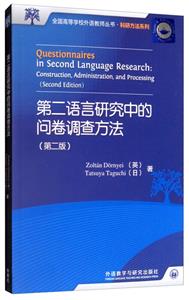全國高等學校外語教師叢書·科研方法系列第二語言研究中的問卷調查方法(2017) 版權信息
- ISBN:9787513514439
- 條形碼:9787513514439 ; 978-7-5135-1443-9
- 裝幀:一般膠版紙
- 冊數:暫無
- 重量:暫無
- 所屬分類:>
全國高等學校外語教師叢書·科研方法系列第二語言研究中的問卷調查方法(2017) 本書特色
佐爾坦·德爾涅伊編著的《第二語言研究中的問卷調查方法》對問卷設計、實施、數據分析等各個階段提供了全面指導,以幫助使用者設計一份有效的問卷。《第二語言研究中的問卷調查方法》包括五章:**章探討了問卷的性質、優缺點及問卷在定性、定量研究中的應用;第二至四章通過大量實例分別詳細介紹了問卷的設計、實施與數據分析方法;第五章提供了一個具體的國外研究實例,展示如何運用書中方法為一個關于學習動機的研究設計問卷。*后,《第二語言研究中的問卷調查方法》特別增加了一個中文研究案例,以幫助國內讀者更好地理解本方法的應用。
全國高等學校外語教師叢書·科研方法系列第二語言研究中的問卷調查方法(2017) 內容簡介
問卷調查在第二語言研究中應用廣泛,問卷的質量往往決定了研究的質量。 《第二語言研究中的問卷調查方法(2017 第2版)》針對問卷設計、實施、數據分析等各個階段為讀者提供了全面指導,以幫助使用者設計一份有效的問卷。 《第二語言研究中的問卷調查方法(2017 第2版)》包括五章:**章探討了問卷的性質、優缺點,及問卷在定性、定量研究中的應用;第二至四章通過大量實例分別詳細介紹了問卷的設計、實施與數據分析方法;第五章提供了一個具體的國外研究實例,展示如何運用書中方法為一個關于學習動機的研究設計問卷。 *后,《第二語言研究中的問卷調查方法(2017 第2版)》特別增加了一個中文研究案例,以幫助國內讀者更好地理解問卷調查方法的應用。 《第二語言研究中的問卷調查方法(2017 第2版)》操作性、實用性很強,也有較高的理論價值。適合外語教學研究工作者使用,也可作為研究方法課程參考書及外語教師培訓參考資料。
全國高等學校外語教師叢書·科研方法系列第二語言研究中的問卷調查方法(2017) 目錄
導讀——第二語言研究中問卷調查法的特點及應用
Preface to the Second Edition
Introduction
Chapter 1 Questionnaires in Second Language Research
1.1 What Are“Questionnaires”and What Do They Measure?
1.1.1 What a Questionnaire Is Not
1.1.2 What Do Questionnaires Measure?
1.2 Using Questionnaires:Pros and Cons
1.2.1 Advantages
1.2.2 Disadvantages
1.3 Questionnaires in Quantitative and Qualitative Research
Chapter 2 Constructing the Questionnaire
2.1 General Features
2.1.1 Length
2.1.2 Layout
2.1.3 Sensitive Topics and Anonymity
2.2 The Main Parts of a Questionnaire
2.2.1 Title
2.2.2 Instructions
2.2.3 Ouestionnaire Items
2.2.4 Additional Information
2.2.5 Final“Thank YDu”
2.3 Appropriate Sampling of the Questionnaire Content and the Significance of“Multi—Item Scales”
2.3.1 Appropriate Sampling ofthe Content
2.3.2 Using Multi—Item Scales
2.4 “Closed.Ended”Ouestionnaire Items
2.4.1 Rating Scales
2.4.2 Multiple—Choice Items
2.4.3 Rank Order Items
2.4.4 Numeric Items
2.4.5 Checklists
2.5 Open—Ended Questions
2.5.1 Specific Open Questions
2.5.2 clarification Questions
2.5.3 Sentence Completion Items
2.5.4 Short—Answer Questions
2.6 HOW to Write Good Items
2.6.1 Drawing Up an“Item Pool”
2.6.2 Rules About Writing Items
2.6.3 WrRing Sensitive Items
2.7 Grouping and Sequencing Items
2.7.1 Clear and Orderly Structure
2.7.2 Opening Questions
2.7.3 Factual(or“Personal”or“Classification”、Questions at the End
2.7.4 Open—Ended Questions at the End
2.8 Translating the Questionnaire
2.8.1 Translation as a Team—Based Approach
2.8.2 Translation with Limited Resources
2.9 Computer Programs for Constructing Questionnaires
2.10 Piloting the Questionnaire and Conducting Item Analysis
2.10.1 Initial Piloting of the Item Pool
2.10.2 Final Piloting("Dress Rehearsal”
2.10.3 Item Analysis
Chapter 3 Administering the Questionnaire.
3.1 Selecting the Sample
3.1.1 Sampling Procedures
3.1.2 How Large Should the Sample Be?
3.1.3 The Problem of Respondent Self.Selection
3.2 Main Types of Questionnaire Administration
3.2.1 Administration bv Mail
3.2.2 One—to—One Administration
3.2.3 Group Administration
3.2.4 Online Administration
3.3 Strategies to Increase the Quality and Quantity of Participant Response
3.3.1 Advance Notice
3.3.2 Attitudes Conveyed by Teachers,Parents,and Other Authority Figures
3.3.3 Respectable Sponsorship
3.3.4 The Presence of a Survey Administrator
3.3.5 The Behavior of the Survey Administrator
3.3.6 Communicating the Purpose and Significance ofthe Survey
3.3.7 Emphasizing Confidentiality
3.3.8 Reading Out the Questionnaire Instructions
3.3.9 The Style and Layout of the Questionnaire
3.3.10 Promising Feedback on the Results
3.4 Questionnaire Administration,Confidentiality,and Other Ethical Issues
3.4.1 Basic Ethical Principles of Data Collection
3.4.2 Obtaining Consent for Children
3.4.3 Strategies for Getting Around Anonymity
Chapter 4 Processing Questionnaire Data
4.1 Coding Questionnaire Data
4.1.1 First Things First:Assigning Identification Codes
4.1.2 Coding Quantitative Data
4.2 Inputting the Data
4.2.1 Creating and Naming the Data File
4.2.2 Keying in the Data
4.3 Processing Closed Questions
4.3.1 Data Cleaning
4.3.2 Data Manipulation
4.3.3 Reducing the Number of Variables in the Questionnaire
4.3.4 Main Types of Questionnaire Data
4.3.5 Examining the Reliability and V.aliditV Ofthe Data
4.3.6 Statistical Procedures to Analyze Data
4.4 Content Analysis of Open—Ended Questions
4.5 Compmer Programs for Processing Questionnaire Data
4.6 Summarizing and Reporting Questionnaire Data
4.6.1 General Guidelines
4.6.2 Technical Information to Accompany Survey Results
4.6.3 Reader.Friendly Data Presentation Methods
4.7 Complementing Questionnaire Data with Other Information
4.7.1 Questionnaire Survey with Follow—up Interview or Retrospection
4.7.2 Questionnaire Survey Facilitated by Preceding Interview
Chapter 5 Illustration:Developing a Motivation Questionnaire
5.1 construction of the Initial Questionnaire
5.1.1 Deciding the ComemAreas to be Covered in the Questionnaire
5.1.2 Designing Items for the Item Pool
5.1.3 Designing Rating Scales
5.1.4 Designing the Personal Information Section
5.1.5 Designing Instructions
5.1.6 Designing the Questionnaire Format
5.1.7 Grouping and Organizing Items and Questions
5.2 Translating and Initial Piloting
5.3 Final Piloting and Item Analysis
5.3.1 Missing Values and the Range of Responses
5.3.2 The Intemal Consistency ReliabjlitV of the Initial Scales
5.3.3 Modification of the Personal Information Items
5.4 The Final Version of the Japanese Ouestionnaire and Post Hoc Item Analysis
5.5 Adapting the Questionnaire for Use in China and Iran
Conclusion and Checklist
References
Appendix A:Combined List of the Items Included in the Questionnaires Discussed in Chapter 5
Appendix B:The Final Version ofthe Questionnaires Used in Japan andChina
Appendix C:Selected List of Published L2 Questionnaires
研究案例:中國大學本科生英語學習動機類型
高一虹、趙媛、程英、周燕
Author Index
Subject Index
- >
經典常談
- >
有舍有得是人生
- >
人文閱讀與收藏·良友文學叢書:一天的工作
- >
煙與鏡
- >
苦雨齋序跋文-周作人自編集
- >
企鵝口袋書系列·偉大的思想20:論自然選擇(英漢雙語)
- >
龍榆生:詞曲概論/大家小書
- >
伊索寓言-世界文學名著典藏-全譯本

















